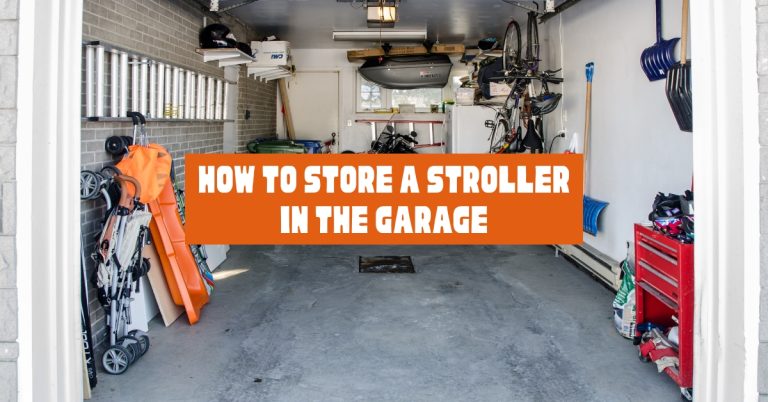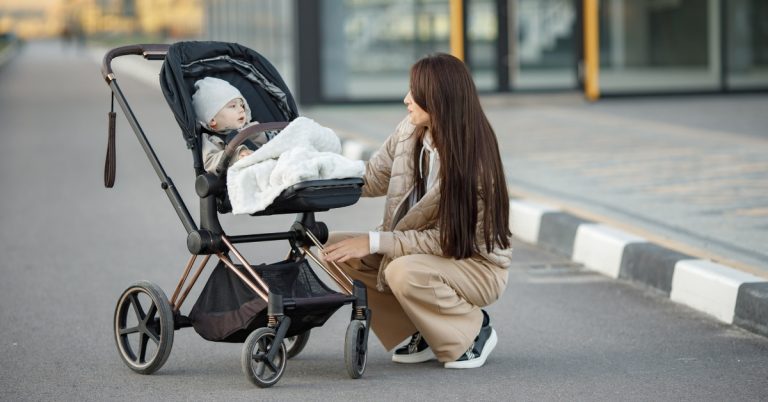As an Amazon Associate, I earn from qualifying purchases.
Your stroller is one of your baby’s most-used items, rolling through parks, sidewalks, and grocery stores while collecting dirt, crumbs, and spills along the way. Regular cleaning isn’t just about keeping your stroller looking fresh—it’s essential for your baby’s health and safety.
Bacteria, allergens, and germs can accumulate on surfaces your little one touches daily. Food particles stuck in crevices attract insects and create unpleasant odors. Beyond hygiene concerns, proper maintenance extends your stroller’s lifespan, protecting your investment and ensuring smooth operation for years to come.
The good news? Learning how to clean a stroller doesn’t require special skills or expensive products. With basic household supplies and about 30 minutes, you can restore your stroller to like-new condition. This guide breaks down the entire process into manageable steps, plus shares pro tips for tackling stubborn stains and maintaining different stroller types.
Contents
When & How Often Should You Clean Your Stroller
The frequency of stroller cleaning depends on how often you use it and where you take it. Here’s a practical cleaning schedule:
After every outdoor adventure: Clean your stroller after trips to the beach, hiking trails, or muddy playgrounds. Sand, dirt, and moisture can damage wheels and fabric if left untreated.
Following food incidents: Spilled snacks and sticky juice boxes require immediate attention. The longer food sits, the harder stains become to remove and the more likely they are to attract pests.
Monthly deep cleaning: Even with regular spot cleaning, give your stroller a thorough wash monthly. This prevents the buildup of grime and keeps all components functioning smoothly.
Seasonal maintenance: Before storing your stroller for winter or bringing it out for spring, perform a comprehensive cleaning and inspection.
You’ll know it’s time to clean when you notice visible dirt, detect odors, or feel sticky surfaces. Trust your instincts—if it looks or smells dirty, it probably needs attention.
Supplies You’ll Need
Gather these basic items before you start. Most parents already have these supplies at home:
- Mild soap (dish soap or baby-safe cleaners work well)
- Warm water
- Soft-bristled brush or clean cloth
- Vacuum cleaner with attachments
- Disinfectant spray (baby-safe formula)
- Microfiber towels
- Baking soda (for odor removal)
- White vinegar (for tough stains)
- Toothbrush (for detailed cleaning)
Avoid harsh chemicals like bleach, ammonia, or abrasive cleaners that could damage fabric or leave harmful residues where your baby sits.
How to Clean a Stroller (Step-by-Step)
Cleaning your stroller doesn’t have to be overwhelming. With a few simple steps, you can keep it fresh, hygienic, and safe for your baby. Follow this easy step-by-step guide to give your stroller a proper deep clean from top to bottom.
Step 1: Disassemble the Stroller
Start by removing all detachable parts. Take off the seat cover, canopy, cup holders, snack trays, and any fabric accessories. Check your owner’s manual if you’re unsure what comes apart—most modern strollers have removable fabric components designed for easy cleaning.
Remove the wheels if possible. Many strollers have quick-release mechanisms that make wheel removal simple. This allows for thorough cleaning of both the wheels and the areas they normally cover.
Step 2: Remove and Wash Fabric Parts
Check care labels on fabric components. Many stroller fabrics are machine washable, but some require hand washing to prevent shrinking or damage.
For machine-washable fabrics: Use cold water on a gentle cycle with mild detergent. Avoid fabric softeners, which can leave residues that attract dirt. Air dry all pieces completely—heat from the dryer can cause shrinkage or damage waterproof coatings.
For hand-wash only items: Fill a basin with warm water and mild soap. Gently agitate the fabric, paying attention to stained areas. Rinse thoroughly with clean water and squeeze out excess moisture without wringing.
Step 3: Clean the Frame
While fabric parts dry, focus on the stroller frame. Use a damp cloth with mild soap to wipe down all metal and plastic surfaces. Pay special attention to:
- Handlebar grips where hands leave oils and dirt
- Folding mechanisms that collect debris
- Under-seat storage areas
- Brake components
For stubborn grime, use a soft brush to gently scrub affected areas. Avoid getting water into electronic components if your stroller has lights or speakers.
Step 4: Scrub and Clean the Wheels
Wheels often carry the most dirt and debris. Remove stuck-on grass, hair, and threads wrapped around axles. Use a brush to scrub tire treads and spokes.
For ball bearings, wipe clean and apply a small amount of bike lubricant if they seem stiff. This keeps wheels rolling smoothly and prevents premature wear.
Don’t forget the wheel wells and brake mechanisms. These areas accumulate dirt that can affect performance and safety.
Step 5: Dry All Parts Completely
This step is crucial for preventing mold and mildew. Air dry all components in a well-ventilated area away from direct sunlight, which can fade colors and weaken fabrics.
Check that fabric pieces are completely dry before reassembling. Even slight dampness can lead to musty odors and bacterial growth.
Cleaning Tips for Different Stroller Types
Not all strollers are built the same, and neither is their cleaning process. Whether you’re dealing with a lightweight umbrella stroller, a strong jogging stroller, or a bulky double stroller, each type has its own care needs. Here are some smart tips for different stroller styles to help you clean more effectively.
Umbrella Strollers
These lightweight models typically have minimal fabric and simple frames. Focus on the seat area and handles. Most umbrella strollers don’t have removable fabric, so use gentle spot cleaning with a damp cloth.
Jogging Strollers
Built for rough terrain, jogging strollers need extra attention to wheels and suspension components. Clean mud and debris from shock absorbers and check that the fixed front wheel spins freely.
Double Strollers
With twice the seating area, double strollers require more time but follow the same basic process. Remove both seat covers and clean each side thoroughly. Check that the folding mechanism works smoothly after cleaning.
Travel System Strollers
These strollers accommodate infant car seats and often have more complex attachment points. Clean all connection points and ensure no soap residue remains that could affect the car seat’s secure fit.
How to Remove Stains, Mold, and Odors
For food stains: Mix equal parts white vinegar and water. Apply to the stain, let it sit for 5 minutes, then gently scrub with a soft brush. Rinse with clean water and air dry.
For mold or mildew: Create a paste with baking soda and water. Apply to affected areas, let sit for 10 minutes, then scrub gently. Rinse thoroughly and dry completely in sunlight if possible.
For persistent odors: Sprinkle baking soda on fabric surfaces, let sit overnight, then vacuum thoroughly. This neutralizes odors without harsh chemicals.
For grease stains: Dish soap works well on greasy fingerprints and food stains. Apply directly to the stain, work in gently, then rinse with warm water.
Common Cleaning Mistakes to Avoid
Using harsh chemicals: Bleach and ammonia can damage fabric and leave harmful residues. Stick to mild, baby-safe products.
Insufficient drying: Rushing the drying process leads to mold and unpleasant odors. Always ensure complete drying before reassembly.
Ignoring wheel maintenance: Dirty wheels affect maneuverability and can transfer grime to clean floors. Regular wheel cleaning is essential.
Forgetting small components: Cup holders, snack trays, and toy bars harbor germs and need regular attention.
Skipping the manual: Each stroller has specific care requirements. Consulting your manual prevents damage and ensures you’re cleaning everything properly.
Keep Your Stroller Fresh and Safe
Regular stroller maintenance protects your investment while ensuring a safe, comfortable ride for your child. The 30 minutes spent cleaning pay dividends in extended stroller life and improved hygiene.
Make cleaning easier by addressing spills immediately and performing quick wipe-downs after each use. Your future self will thank you when monthly deep cleaning becomes a simple routine rather than a major project.
Remember that a clean stroller isn’t just about appearance—it’s about creating a healthy environment for your little one’s daily adventures.
Frequently Asked Questions
Can stroller fabric go in the washing machine?
Most modern stroller fabrics are machine washable, but always check the care label first. Use cold water and a gentle cycle, then air dry to prevent shrinkage.
What’s a safe cleaner for baby gear?
Mild dish soap, baby-safe all-purpose cleaners, or a mixture of warm water and white vinegar are safe options that effectively clean without leaving harmful residues.
How do I get rid of food stains on stroller seats?
Mix equal parts white vinegar and water, apply to the stain, let sit for 5 minutes, then gently scrub with a soft brush. Rinse with clean water and air dry.
Is it safe to use bleach on strollers?
No, avoid bleach and other harsh chemicals. They can damage fabric, fade colors, and leave residues that could irritate your baby’s skin.
How often should stroller wheels be cleaned?
Clean wheels after outdoor use, especially on muddy or sandy surfaces. Monthly wheel maintenance prevents buildup that affects performance and maneuverability.
As an Amazon Associate, I earn from qualifying purchases.



Pingback: How to Secure a Stroller | Essential Safety Tips for Parents